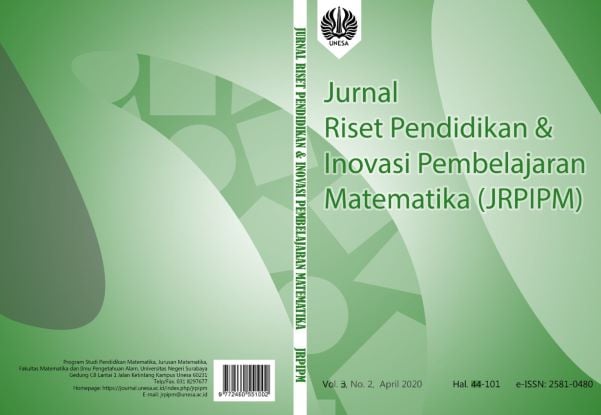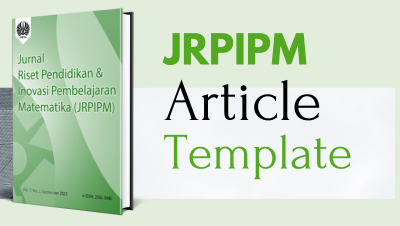Analisis Kesulitan Siswa SMP dalam Menyelesaikan Soal Materi Teorema Pythagoras
DOI:
https://doi.org/10.26740/jrpipm.v3n2.p61-67Keywords:
Difficulty Analysis, Pythagoras TheoremAbstract
Difficulties experienced by students in learning greatly affect the achievement of student learning outcomes. This study aims to describe the results of the identification of the types of difficulties and the causes of student difficulties when solving problems based on Polya stages. This type of research is descriptive qualitative with the instrument used in written tests. The subjects of the research were 36 students of class IX at SMP Negeri 9 Cimahi. Based on the analysis that has been done, it can be concluded that the difficulties experienced by junior high school students when completing the Pythagorean theorem questions in the school are 1) difficulty understanding the problem 100%, 2) difficulty planning the completion of 40%, 3) difficulty implementing the plan 54.4%, and 4) difficulty in re-checking 76.7%. The causes of difficulties include 1) students are not accustomed to writing things that are known and asked of a problem 2) students are not accustomed to drawing conclusions from a mathematical problem 3) Concept errors because students do not understand the concept of the material. So, it is necessary to improve the learning process that prioritizes learning concepts rather than memorizing. Students must be accustomed to solving the application problems of a material. So, students will be able to solve contextual problems related to the material.
References
[1] E. Suherman, Turmudi, D. Suryadi, T. Herman, Suhendra, S. Prabwanto, Strategi Pembelajaran Matematika Kontemporer. Bandung: Universitas Pendidikan Indonesia, 2003.
[2] M. L. Riajanto, Pengembangan Pembelajaran Era Post Modern Menuju Ketercapaian Kemampuan Matematis Siswa. Jurnal Ilmiah Program Studi Matematika STKIP Siliwangi Bandung, 81, 2014.
[3] A. Yusuf, dan N. Fitriani, "Analisis Kesalahan Siswa Smp Dalam Menyelesaikan Soal Persamaan Linear Dua Variabel Di Smpn 1 Campaka Mulya-Cianjur". JPMI (Jurnal Pembelajaran Matematika Inovatif) vol. 3, no. 1 (2020): 59-68.
[4] G. Yadrika, S. Amelia, Y. Roza, dan Maemunah, "Analisis Kesalahan Siswa SMP dalam Menyelesaikan Soal pada Materi Teorema Pythagoras dan Lingkaran". JPPM (Jurnal Penelitian dan Pembelajaran Matematika) vol. 12, no. 2 (2019): 195-212.
[5] T. N. Fitria, "Analisis Kesalahan siswa dalam menyelesaikan soal cerita berbahsa inggris pada materi persamaan dan pertidaksamaan linear satu variabel", MATHEdunesa 2, no. 1 (2013)
[6] Sumaryanta, "Pedoman Penskoran", Indonesian Digital Journal of Mathematics and Education, vol. 2, no. 3, 2015, 181-90.
[7] M. L. Riajanto, Peningkatan Kemampuan Pemahaman Geometris Siswa Smp Melalui Pendekatan Matematika Realistik Berbantuan Software Geometer's Sketchpad. Bandung : Universitas Pendidikan Indonesia, 2014
[8] I. Hasibuan, "Hasil Belajar Siswa Pada Materi Bentuk Aljabar Di Kelas Viism Negeri 1 Banda Aceh Tahun Pelajaran 2013/2014". Jurnal Peluang vol. 4, no. 1 ,2015,10-11.
[9] M. Rohmah, dan S. Sutiarso, "Analysis Problem Solving in Mathematical Using Theory Newman", EURASIA Journal of Mathematics, Science and Technology Education, vol. 14, no. 2, 2018, 671-681.
[10] H. Hendriana, dan N. Fitriani, "Mathematical Abstraction Of Year 9 Students Using Realistic Mathematics Education Based On The Van Hiele Levels Of Geometry". Jurnal Didaktik Matematika, vol. 6, no. 1, 2019, 1-11.
Downloads
Additional Files
Published
How to Cite
Issue
Section
 Abstract views: 1658
,
Abstract views: 1658
, PDF Downloads: 2741
,
PDF Downloads: 2741
, PDF Downloads: 0
PDF Downloads: 0






